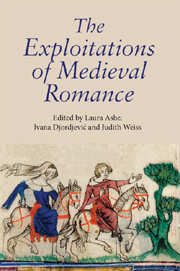Book contents
- Frontmatter
- Contents
- Preface
- Notes on Contributors
- Abbreviations and Editorial Note
- Introduction
- 1 The Fairies in the Fountain: Promiscuous Liaisons
- 2 Saracens and Other Saxons: Using, Misusing, and Confusing Names in Gui de Warewic and Guy of Warwick
- 3 The Exploitation of Ideas of Pilgrimage and Sainthood in Gui de Warewic
- 4 Chanson de geste as Romance in England
- 5 Patterns of Availability and Demand in Middle English Translations de romanz
- 6 Reading a Christian–Saracen Debate in Fifteenth-Century Middle English Charlemagne Romance: The Case of Turpines Story
- 7 Subtle Crafts: Magic and Exploitation in Medieval English Romance
- 8 Meeting Grounds: Gardens in Middle English Romance
- 9 ‘Als for the worthynes of þe romance’: Exploitation of Genre in the Buik of Kyng Alexander the Conquerour
- 10 Sir Gawain and the Green Knight and the Limits of Chivalry
- Index of Manuscripts
- General Index
2 - Saracens and Other Saxons: Using, Misusing, and Confusing Names in Gui de Warewic and Guy of Warwick
Published online by Cambridge University Press: 12 September 2012
- Frontmatter
- Contents
- Preface
- Notes on Contributors
- Abbreviations and Editorial Note
- Introduction
- 1 The Fairies in the Fountain: Promiscuous Liaisons
- 2 Saracens and Other Saxons: Using, Misusing, and Confusing Names in Gui de Warewic and Guy of Warwick
- 3 The Exploitation of Ideas of Pilgrimage and Sainthood in Gui de Warewic
- 4 Chanson de geste as Romance in England
- 5 Patterns of Availability and Demand in Middle English Translations de romanz
- 6 Reading a Christian–Saracen Debate in Fifteenth-Century Middle English Charlemagne Romance: The Case of Turpines Story
- 7 Subtle Crafts: Magic and Exploitation in Medieval English Romance
- 8 Meeting Grounds: Gardens in Middle English Romance
- 9 ‘Als for the worthynes of þe romance’: Exploitation of Genre in the Buik of Kyng Alexander the Conquerour
- 10 Sir Gawain and the Green Knight and the Limits of Chivalry
- Index of Manuscripts
- General Index
Summary
In a genre not known for its faithful representation of reality, including geographic reality, the Middle English and, even more, Anglo-Norman versions of the romance of Guy of Warwick stand out for their surprising fidelity to verifiable geographical fact. This is not to say that there would be any point in trying to recreate the hero's itinerary as he wanders over large parts of Britain, Europe, and the Middle East, for it would soon become obvious that the distances are impossible and the spatial relationships between the numerous places mentioned in the text often confused. But many of these places bear the names of actual geographical locations, and if their exact coordinates are sometimes hard to determine they are at least situated in the correct part of the world, which is more than can be said of many other texts in the same genre.
The earliest version of this popular narrative, Gui de Warewic (hereafter Gui), is a late product in the development of Anglo-Norman romance whose author deftly constructs a vast and realistic theatre of action for his hero by means of prodigal, yet often well-informed, geographical name-dropping. The toponyms and ethnonyms he uses are culled from a variety of sources, both popular (chansons de geste, other romances) and learned (historical and pseudo-historical writings of different kinds); and while the role of significant names can be merely decorative, there are times when they are exploited with a specific agenda in mind.
- Type
- Chapter
- Information
- The Exploitations of Medieval Romance , pp. 28 - 42Publisher: Boydell & BrewerPrint publication year: 2010

